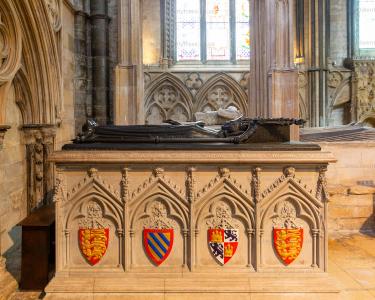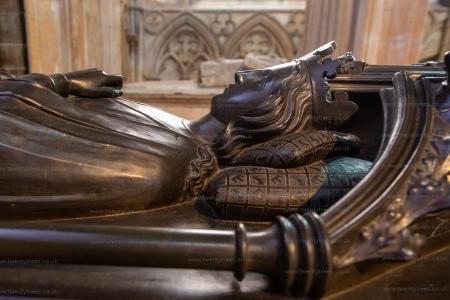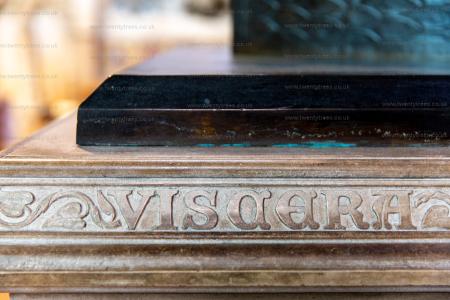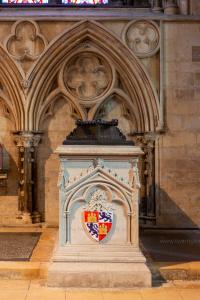Europe, British Isles, North-Central England, Nottinghamshire, Harby [Map]
Harby is in Nottinghamshire.
After 28 Nov 1290 Eleanor of Castile's (age 49) body was taken from Harby [Map] to Westminster Abbey [Map]. At each of the locations at which her body rested overnight King Edward "Longshanks" I of England (age 51) commissioned the building of an Eleanor Cross. Three remain. The best example being at Geddington, Northamptonshire [Map].
On 09 Jan 1957 de Havilland DH.100 Vampire FB.Mk 5 VZ860 crashed a Harby [Map] killing two people. The aircraft was engaged in formation flying and a tail chase over Nottinghamshire. The aircraft climbed to 30,000 feet, and subsequently descended to 18,000 feet, and carried out a number of formation changes. After a dive, the leading aircraft in the formation pulled up, but Vampire VZ860 did not follow suit, and was seen disappearing into cloud at 11,000 feet, still descending. The pilot made no attempt to correct the descent, and Vampire VZ860 dived into the centre of Harby village, Nottinghamshire, after presumed hypoxia of the pilot (caused by lack of oxygen at high altitude)...which would explain the lack of any corrective action to pull out of its terminal dive. The pilot* and a woman civilian** on the ground were killed, and three other women were injured. One house was demolished and three others were seriously damaged.
Pilot - Pilot Officer Stanley Monro, RAF (Service Number 2739859, aged 23)
Civilian casualty - Mrs. Lois Towning (aged 64)
Mrs. Towning was an elderly lady who was ironing when the aircraft crashed straight into her cottage. The surrounding cottages were also badly damaged injuring three other women who had to be dug out of their homes after roofs and walls collapsed (Miss M. Oliphant, Miss P.M.Richardson, and Miss D. Goldcare). The crash site is now the site of Harby Village Hall. Pilot Officer Monro is now buried at Retford Road Cemetery, Worksop, Nottinghamshire
The crash location of Harby is the easternmost village in the English county of Nottinghamshire and is close to the Nottinghamshire/Lincolnshire border. The nearest large town is Lincoln, over the border in Lincolnshire, about 10 miles to the east. Which explains why the Air Ministry official record file on the incident (File BT233/380) lists the crash location as "Harby Village (near Lincoln) Notts".
Archaeologia Volume 29 Section XIII. She died at a place called Herdeby (Hardby) [Map], near Lincoln, on the 28th of November 1290, which was a few days after the commencement of the 19th year of her husband's reign. Mr. Gough has shewn, in a manner perfectly satisfactory, that Bishop Gibson and Dr. Stukeley were mistaken when they pointed out Hardby near Bolinbroke as the place of the Queen's death. There can be no doubt that the place in question is as Mr. Gough states, a little village called Hardby, on the Lincolnshire side of the Trent, but in the county of Nottingham (five miles west of Lincoln), which by this event, and this event only, is brought into notice.
Mr. Gough's proofs are sufficient, but if more were needed, more will be supplied in the course of this communication. Hardby is a member of the parish of North Clifton, a prebend in the church of Lincoln, and, at the time of which we are speaking, was a manor belonging to a family who had the surname of Weston.
Archaeologia Volume 29 Section XIII. To account for the Queen being at this place [Map] at the time of her illness and death, it is usually said that she was accompanying the King on his way to Scotland, and that falling ill she was left behind. It is added that the King, when he was approaching the borders of Scotland, ("dum finibus Scotie appropinquaret [while he was approaching the borders of Scotland]," are the words of Walsinghama,) received intelligence of her death, returned to the place where she lay, and accompanied the funeral procession to London, giving up his intended expedition to Scotland. In this there are very material errors. I do not mean to say that when the King left Westminster in the summer of that year he did not design to proceed to the borders of Scotland, or that when he summoned the Parliament to meet at Clipston, a royal palace in the forest of Sherwood, about twenty miles from Hardby [Map], in the autumn, it was not with a view of being nearer to Scotland than he would have been at London; but that he went with no kind of haste, and that so far from ever approaching the borders of Scotland, he was never in that year further north than Clipston, except that he made a short hunting excursion in the forests of the High Peak and Macclesfield. It will also further appear that, so far from being on the Scottish border when he received information of the Queen's death, he was with her at Hardby [Map] at the time of her death, and for several days preceding.
Note a. They are also the words of Trivet, p. 268; in fact the verbal conformity between Trivet and Walsingham plainly shews that one copied the other, or that both copied from a common original.
Archaeologia Volume 29 Section XIII. The Parliament was held at Clipston, and all the writs are tested there till the 11th, 12th, or 13th of November.
By the 14th of November the King had left Clipston and was moving in the direction of Hardby. He was several days at Laxton, from whence he removed to Marnham, and on the 20th he was at Hardby.
There are writs dated at Hardby [Map] every day from the 20th to the 28th of November, on which day the Queen died.
Europe, British Isles, North-Central England, Nottinghamshire, Harby, All Saints Church [Map]
All Saints Church, Harby [Map] with statue of Eleanor of Castile Queen Consort England who died at nearby Harby Manor in 1290.



All Saints Church, Harby [Map]. Memorial to Charles Walter Plant of the Royal Lincolnshire Regiment died 23 Oct 1947 aged 30. Son of Charles Amos and Eliza Ann Plant; husband of Dorothy Ellen Plant, of Caythorpe, Lincolnshire.

Europe, British Isles, North-Central England, Nottinghamshire, Harby Manor
Behind the churchyard the location of Harby Manor, owned by Richard de Weston, where Eleanor of Castile Queen Consort England died in 1290.

Archaeologia Volume 29 Section XIII. The Queen (age 49) died of a lingering disease, a slow fever. Wikes says, "modicz febris igniculo contabescensd [of fever burning with fire]." We see therefore why the more quiet situation of Harby Manor should be chosen for her rather than Clipston, where the Court and Parliament were to be held. I have not seen any positive evidence respecting the time when the Queen first took up her abode at this obscure place. The latest date at which I find the King and Queen together is late in the month of August, when a certain sum was paid to a messenger for carrying joint letters of the King and Queen from Northampton to the Earl of Gloucester. On the 18th of October 13s. 4d. was paid to Henry de Montepessulano for syrops and other medicines bought for the Queen's use at Lincoln. In that interval I conclude she was placed at Hardby, and probably about the 11th of September, when it appears the King was there.
Note d. Gale, p. 121. Wikes states that she died at Grantham. It is difficult to account for positive assertions like this in writers who are in the main deserving of credit. Langtoft says, That ilk sere pe quene died in Lyndseie. (p. 248.)
This is worth notice, as assisting to determine the ancient limits of the district called Lindsey.
On 28 Nov 1290 Eleanor of Castile Queen Consort England (age 49) died at Harby Manor. Her viscera were buried at Lincoln Cathedral [Map].



